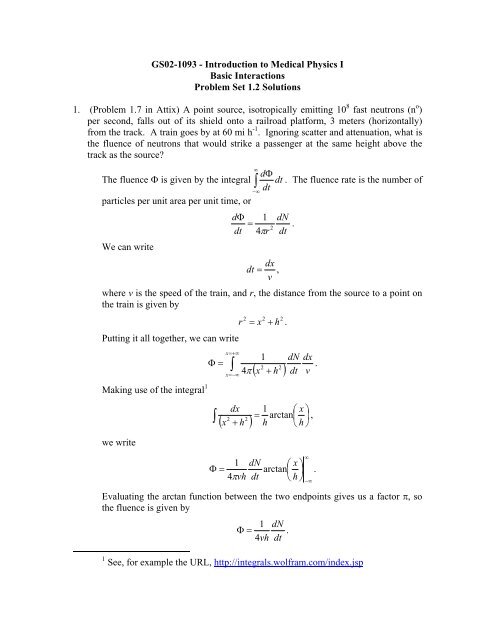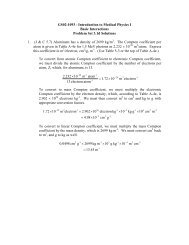link to Problem Set 1.2 Solutions - uthgsbsmedphys.org
link to Problem Set 1.2 Solutions - uthgsbsmedphys.org
link to Problem Set 1.2 Solutions - uthgsbsmedphys.org
Create successful ePaper yourself
Turn your PDF publications into a flip-book with our unique Google optimized e-Paper software.
GS02-1093 - Introduction <strong>to</strong> Medical Physics I<br />
Basic Interactions<br />
<strong>Problem</strong> <strong>Set</strong> <strong>1.2</strong> <strong>Solutions</strong><br />
1. (<strong>Problem</strong> 1.7 in Attix) A point source, isotropically emitting 10 8 fast neutrons (n o )<br />
per second, falls out of its shield on<strong>to</strong> a railroad platform, 3 meters (horizontally)<br />
from the track. A train goes by at 60 mi h -1 . Ignoring scatter and attenuation, what is<br />
the fluence of neutrons that would strike a passenger at the same height above the<br />
track as the source?<br />
<br />
d<br />
The fluence is given by the integral dt . The fluence rate is the number of<br />
dt <br />
particles per unit area per unit time, or<br />
d<br />
1 dN<br />
. 2<br />
dt 4r<br />
dt<br />
We can write<br />
dx<br />
dt ,<br />
v<br />
where v is the speed of the train, and r, the distance from the source <strong>to</strong> a point on<br />
the train is given by<br />
r <br />
Putting it all <strong>to</strong>gether, we can write<br />
Making use of the integral 1<br />
we write<br />
2 2 2<br />
x h .<br />
x<br />
1<br />
<br />
2<br />
4<br />
x<br />
dx<br />
dN<br />
dt<br />
dx<br />
.<br />
2 xh v<br />
1<br />
x <br />
,<br />
<br />
arctan<br />
2 2 <br />
xh h h<br />
1 dN x <br />
arctan<br />
<br />
4vh<br />
dt h <br />
Evaluating the arctan function between the two endpoints gives us a fac<strong>to</strong>r , so<br />
the fluence is given by<br />
1 dN<br />
.<br />
4vh<br />
dt<br />
1 See, for example the URL, http://integrals.wolfram.com/index.jsp<br />
<br />
<br />
.
We have<br />
dN<br />
dt<br />
8 -1<br />
10<br />
sec<br />
, v = 60 mi h -1 , and h = 3 m, so<br />
hr<br />
8 -1<br />
<br />
10<br />
sec<br />
4<br />
60 mi<br />
3 m<br />
8<br />
10 hr 60<br />
min 60<br />
sec<br />
mi<br />
ft<br />
<br />
4<br />
60 mi<br />
3 m sec<br />
hr min<br />
5280<br />
ft 0.3048 m<br />
5 -2<br />
3.<br />
1110<br />
m<br />
2. Show that absorbed dose has the same units as velocity squared. What, if anything,<br />
does this imply about the relation of dose <strong>to</strong> velocity?<br />
Units for absorbed dose are [energy mass -1 ]. Because the units for energy are<br />
[mass velocity 2 ], the units for absorbed dose are [velocity 2 ]. This implied nothing<br />
about the relation of dose <strong>to</strong> velocity because dose and velocity are two<br />
completely different quantities; they just have the same units.<br />
3. (<strong>Problem</strong> 1-5 in Attix) A point source of 60 Co emits equal numbers of pho<strong>to</strong>ns of 1.17<br />
and 1.33 MeV giving a flux density (ICRU #60 calls it “fluence rate”) of 5.7 10 9<br />
pho<strong>to</strong>n cm -2 s -1 at a specified location. What is the energy flux density (ICRU # 60<br />
now calls it “energy fluence rate”) expressed in MeV cm -2 s -1 and in J m -2 min -1 ?<br />
The energy fluence rate <br />
can be obtained from the pho<strong>to</strong>n fluence rate <br />
by<br />
multiplying the pho<strong>to</strong>n fluence rate by the energy. When we have a polyenergetic<br />
spectrum, we can sum over the energy components.<br />
<br />
<br />
EEE f i i i ,<br />
i<br />
where f(Ei) is the fraction of pho<strong>to</strong>ns with energy Ei. In this example, the fraction<br />
of pho<strong>to</strong>ns with each of the two energies is 0.5. Thus<br />
<br />
<br />
9<br />
9<br />
0. 51.<br />
17<br />
5.<br />
710<br />
0.<br />
51.<br />
33<br />
5.<br />
710<br />
<br />
9<br />
-2<br />
7.<br />
1310<br />
MeV cm sec<br />
-1<br />
<br />
MeV cm<br />
6<br />
19<br />
4<br />
9 MeV 10 eV 1.<br />
610<br />
J 10 cm<br />
7.<br />
1310<br />
2<br />
2<br />
cm sec MeV eV m<br />
-2<br />
-1<br />
684 J m min<br />
2<br />
-2<br />
sec<br />
60 sec<br />
min<br />
-1
4. (<strong>Problem</strong> 1-8 in Attix) An x-ray field at a point P contains 7.5 x 10 8 m -2 s -1 keV -1 ,<br />
uniformly distributed from 10 <strong>to</strong> 100 keV. (We might symbolize this, using ICRU#60<br />
notation, as d<br />
<br />
<br />
d d d d dN<br />
E <br />
dt dE ).<br />
dE dE dt da <br />
a. What is the pho<strong>to</strong>n fluence rate at P?<br />
The pho<strong>to</strong>n fluence rate is found by integrating E<br />
over the energy<br />
spectrum of the pho<strong>to</strong>ns, so we write<br />
100 keV<br />
<br />
dE<br />
10 keV<br />
E<br />
8<br />
90 keV 7.510<br />
m<br />
10<br />
6.<br />
7510<br />
m<br />
-2<br />
b. What would be the pho<strong>to</strong>n fluence in one hour?<br />
Because the pho<strong>to</strong>n fluence rate is constant the pho<strong>to</strong>n fluence is found by<br />
multiplying the pho<strong>to</strong>n fluence rate by the time, so we write<br />
<br />
t<br />
sec<br />
10<br />
6.<br />
7510<br />
m<br />
1<br />
-2<br />
-2<br />
sec<br />
sec<br />
1<br />
1<br />
1hr<br />
keV<br />
10 hr 3600<br />
sec<br />
6.7510<br />
2<br />
m sec<br />
hr<br />
14 -2<br />
2.<br />
4310<br />
m<br />
c. What is the corresponding energy fluence in J m -2 ?<br />
The energy fluence is determined by first integrating E<br />
E over the<br />
energy spectrum of the pho<strong>to</strong>ns <strong>to</strong> get the energy fluence rate.<br />
<br />
100 keV<br />
E<br />
EdE<br />
<br />
10 keV<br />
1<br />
2<br />
<br />
E<br />
E<br />
2<br />
3.<br />
7110<br />
100 keV<br />
10 keV<br />
8<br />
0.<br />
5<br />
7.510<br />
m<br />
12<br />
-2<br />
keV m<br />
sec<br />
-2<br />
1<br />
sec<br />
keV<br />
1<br />
1<br />
<br />
1<br />
2 2 2 2<br />
100 keV 10<br />
keV
We now multiply the energy fluence rate by the time <strong>to</strong> get the energy<br />
fluence.<br />
t<br />
3.<br />
7110<br />
3.7110<br />
<br />
<br />
<br />
<br />
2.<br />
14 J<br />
m<br />
12<br />
12<br />
1.<br />
3410<br />
16<br />
1.<br />
3410<br />
16<br />
-2<br />
keV m<br />
keVm<br />
-2<br />
-2<br />
sec<br />
1<br />
1hr<br />
keV hr<br />
3600<br />
sec<br />
2<br />
m sec<br />
hr<br />
-2<br />
keV m<br />
1.<br />
610<br />
19<br />
J eV<br />
-1<br />
10<br />
3<br />
eV keV<br />
-1





